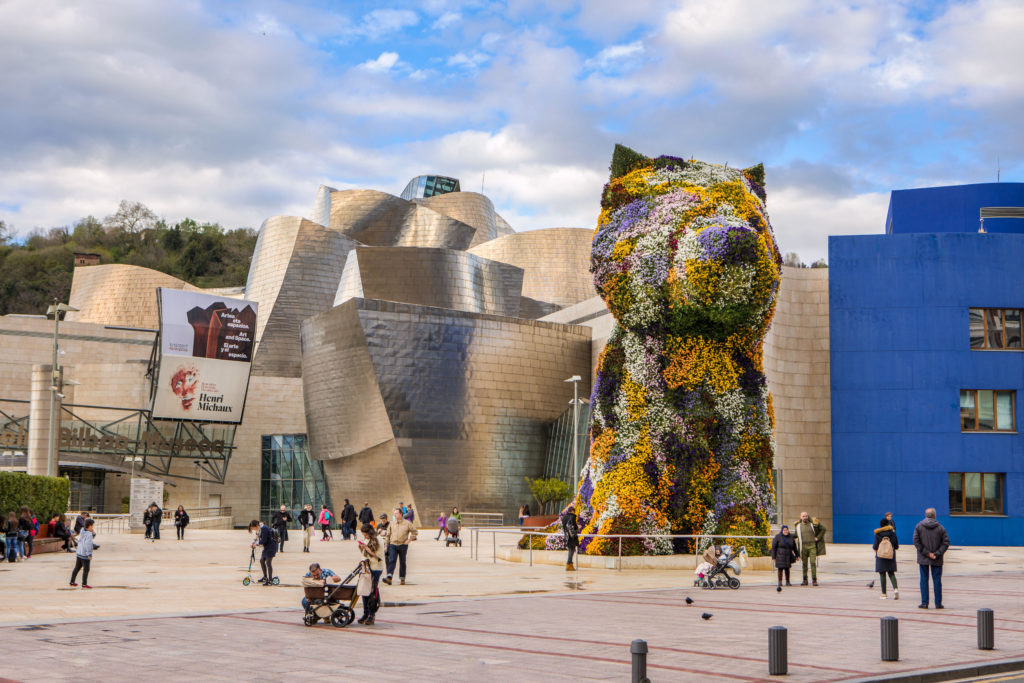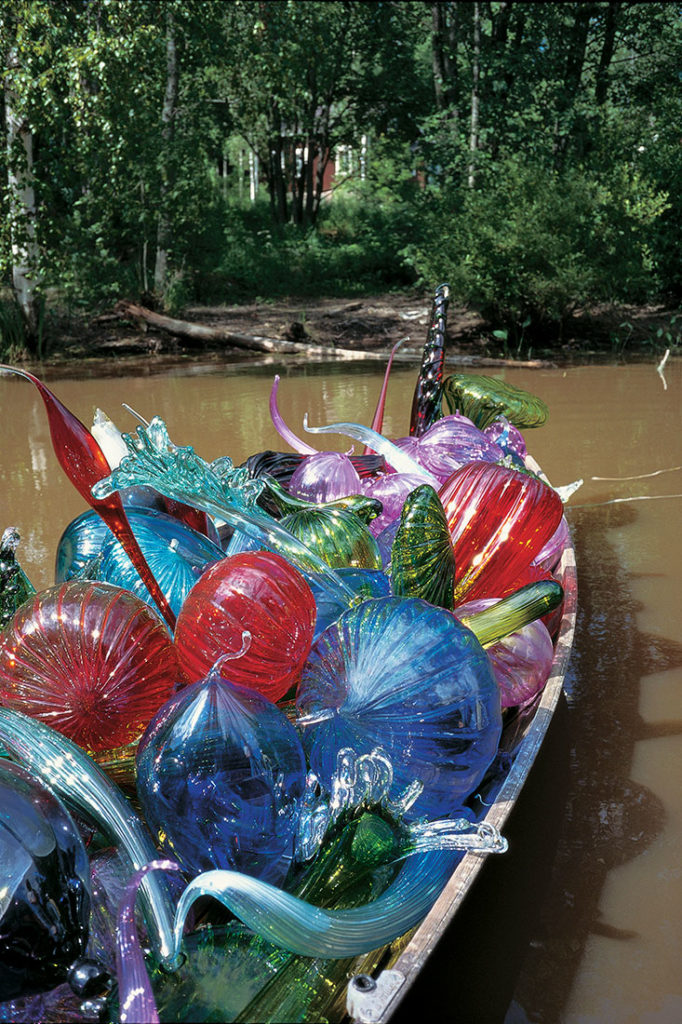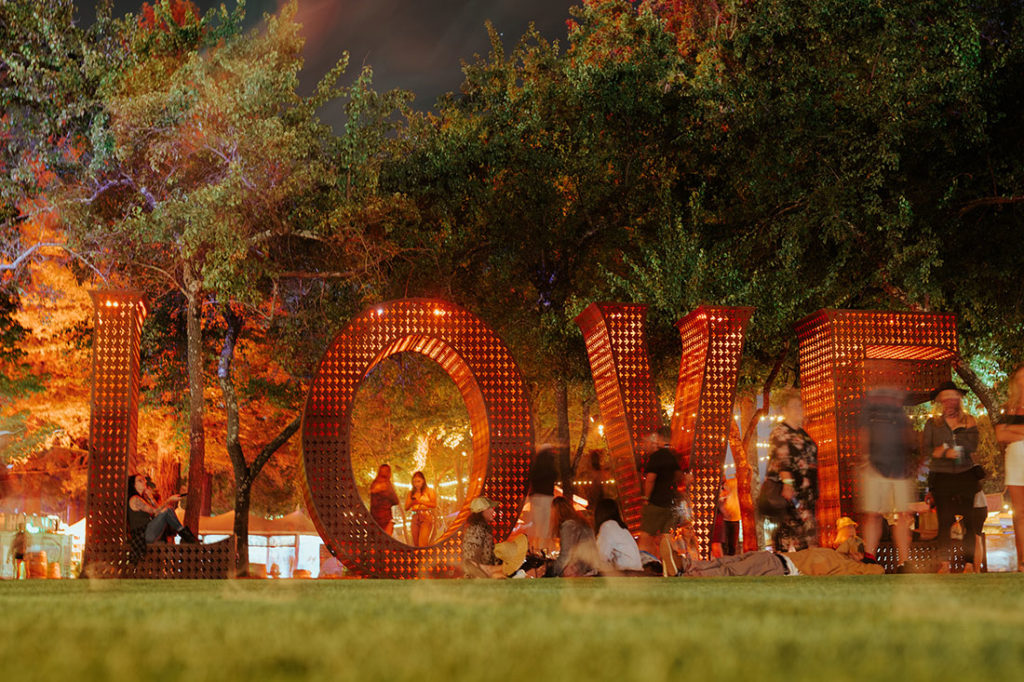Much of art was once cloistered away to be experienced in specific venues, in specific ways, by specific people. To a large degree, large-scale art installations have upended these ideas by inserting themselves into unexpected spaces, at sometimes ridiculous sizes, and shrugging off or even spoofing artistic convention—like how Jeff Koons’ enormous Puppy turns formal 18th-century topiary into a Chia Pet.
Art installations are usually temporary, often outdoors and frequently disruptive to a natural or curated space, influencing our experience of an environment and challenging our ideas about communal spaces, art and cultural expectations. Over the past 60 years, and more dramatically in the past 10, this art form has evolved into a means of creating immersive experiences between the viewer and the art, most recently through high-tech, multimedia presentations that surround and encompass the viewer.
Today’s innovators—whether in galleries, event venues or cities—are using these installations to reinvent how we can interact with art.

Early Influencers
When Christo Vladimirov Javacheff and Jeanne-Claude de Guillebon exploded into the world’s artistic consciousness in the early 1960s, their larger-than-life art installations captured imaginations. They were two of the first to create temporary art installations as we know them today, the true early influencers of this now-popular movement that began in the 1950s and ’60s. Christo and Jeanne-Claude helped cause a seismic shift in how people the world over perceived art, taking it out of galleries and museums and merging it with the environment. They turned found materials into political commentary by stacking hundreds of used oil barrels into walls across European cities following the raising of the Berlin Wall in 1961. Their oil-barrel walls rose in Paris (1962), Munich (1963) and Ottero, the Netherlands (1966); all created “iron curtain” barricades, representing social and political repression. Some, like the installation in Paris, were done in a guerrilla style, as they illegally stopped traffic to place the barrels and drew police intervention, which helped grow their reputation as artists who were doing something radically different.

Exploring social, political and environmental themes were always fundamental to their installations and in keeping with the turbulence of the 1960s and beyond. They shook up the art world with their wrapped structures that drew attention to architecture or natural landscapes, including the Wrapped Kunsthalle (Bern, 1967-8), Wrapped Coast (Sydney, 1969), The Pont Neuf Wrapped (Paris, 1975-85) and Wrapped Reichstag (Berlin, 1971-95). And that was all before their most famous collaboration: the 1991 twin installations known as The Umbrellas, 3,100 of which stretched across valleys in California and Japan in bright yellow and blue, respectively, for 18 days in 1991. The umbrellas marked a seminal moment in the history of art installations, costing an astounding and self-funded $26 million to accomplish and becoming an international sensation. Artist Saul Steinberg, reflecting on Christo’s genius in the New York Times upon his death in 2020, wrote that “He not only invented himself, he invented his art, and, even more amazing, he invented his public.”
Glass sculptor Dale Chihuly emerged as another early influencer and political voice in the early 1970s while working as an instructor at Rhode Island School of Design. His first glass installations (done with fellow artist James Carpenter) included Glass Environment #3, a blood-invoking glass object installed in the basement of a former funeral home; viewers believed the work reflected his anti-Vietnam War stance. As more political works followed, Chihuly’s reputation began to grow. Chihuly (along with fellow artist John Landon) opened the Pilchuck Glass School back in Chihuly’s Western home state of Washington, rejecting the Eastern establishment and taking the next step toward being two of the world’s most renowned glass artists.
As his career morphed over the ensuing decades, Chihuly has adorned towers and gardens with fanciful, colorful creations, floated boats filled with glass sculptures down rivers (as in The Boat, Finland, 1995), hung chandeliers over city streets and canals (as in Chihuly Over Venice, 1995-6) and bedecked gardens with towering glass creations, including the New York Botanical Garden (in 2006 and 2017) and the Royal Botanic Gardens, Kew (in London, 2005 and 2018), in the process becoming one of the most sought-after installation artists in the world.

In the 1980s, pop artist-sculptor Jeff Koons appeared on the scene, making a big splash with his New Museum window installation The New, which featured vacuum cleaners and other appliances. Koons quickly rose to fame and fortune, creating pop art sculptural installations (as well as paintings) that often polarized critics and the public. His mammoth 1992 Puppy, a 43-foot living plant sculpture of a West Highland terrier, has towered outside museums in the U.S., Australia, Germany, New Zealand and Spain, where it finally sits permanently outside the Guggenheim Museum in Bilbao. It’s one of the world’s most iconic art installation sculptures, made even more popular in recent times by the advent of social media’s love of posting Instagram shots of cool, quirky art installations—one of the factors driving the worldwide surge in immersive experiences.
One of the most famous and most fleeting annual art installations began in 1986, at the first Burning Man, in San Francisco. The annual ritual now held on the Playa in Black Rock Desert, Nevada, offers a space for avant-garde artworks designed to be built and dismantled for the festival—or burned, in the case of the actual Burning Man wooden sculpture that’s created and torched every year.
Lighting Up
British artist Bruce Munro pioneered a now-burgeoning trend of using solar-powered fiber optic light displays to create immersive experiences, through his large outdoor Field of Light installations—first in his own backyard in 2003, and later in the Australian outback, where he was originally inspired by the energy and light of the sweeping desert to create what looks like a field of primary-colored night-blooming flower bulbs. To experience his works, you have to walk inside the light garden itself, which creates an immersive experience that lasts for over 20 minutes (or more, depending on how long you linger). Munro’s marriage of nature and technology often begins as a temporary installation and eventually becomes a permanent fixture of the landscape. With his installations now twinkling in fields across the world—and raking in hefty admission prices—Munro is proof of the popularity of these immersive experiences.

“I think outdoor art installations give space and allow people to experience the work on their own terms,” Munro muses. Munro’s influence in creating popular technically driven art installations has been echoed in similar experiences, such as Vivid Sydney, the annual festival of fiber optic and LED light installations and projections on buildings all across the city—including its iconic opera house. That 23-day celebration has drawn millions of attendees each year since 2009 (except for the pandemic years). Canberra’s own version, the Enlighten Festival, has been (literally) spotlighting artists since 2011; this year’s event featured Hugh Burrell’s 16-foot-high Five Elements Orrery, which combined wind-driven metal spheres and arms lit with LED lights to create a massive moving sculpture.
Enhancing Experiences
Following Burning Man’s example, music festivals have embraced art installation. This year’s Coachella Valley Music and Arts Festival featured various artists’ works that included Architensions’ Playground, a four-towered, multicolored structure glowing with LED optics at night. This installation drew crowds to the highly-coveted seating it offered and to its Instagram-worthy visuals. Following in Jeff Koons’ footsteps were the two Mutts created by Oana Stanescu—red and yellow dog sculptures filled with live flowers and plants, another social media favorite.
New Orleans’ annual Halloween-weekend Voodoo Fest displays new art every year too—a blend of large-scale, commissioned art pieces and sponsored art installations, such as Pepsi’s geodesic dome video experience: a glowing white dome offering bean bag seats that allowed visitors to lay back and enjoy a colorful psychedelic film projected on the ceiling. BottleRock Napa Valley sets its musical performances and flowing wines against a more permanent backdrop: Laura Kimpton’s LOVE sculpture has been a fixture since the fest’s inauguration in 2013 and serves as a photo op as festers climb inside of the letters and pose.

“Art is an important part of the festival experience, integrating visual arts with the performing arts,” explains Justin Dragoo, who co-produces BottleRock. “The pieces we own or showcase absolutely enhance the vibe we are looking to provide our attendees. Laura Kimpton’s LOVE reflects exactly what BottleRock is all about: peace, love and great music.”
Total Immersion
The past decade has hatched a new and highly profitable art installation concept: immersive, top-to-bottom rooms that bring viewers into the works of a famous artist, using technology to overwhelm the senses.
Annabelle Mauger began this trend with the 2007 Van Gogh immersion she produced and directed; Imagine Van Gogh has since been followed with Imagine Monet and the new Imagine Picasso.

“Immersion makes the art accessible to a younger audience and easy to present on social networks, for those who want to share their experience,” Mauger says. “The visitor finds himself at the center of the painting, devoid of all the academic codes of traditional museum visits: Visitors are free to sing, to dance, to jump into the space and to self-appropriate this journey.”
Mario Iacampo, president and creative director of Exhibition Hub, which produces Van Gogh Exhibit: The Immersive Experience (a different immersion—this is such a lucrative space that numerous companies are doing parallel immersions), Monet: The Immersive Experience, Banksy: Genius or Vandal and Frida Kahlo: The Life of an Icon, agrees as to the appeal.
“The pure enjoyment of art appeals to all of us,” Iacampo says, “and when you combine it with the ability to be surrounded by and subsumed into a painting—that covers the floors and the walls and moves all around you—that can transport you to places you’d never expect until you stepped into it.”
The Future of Immersive Art
With studies such as HERE Institute’s 2020 Immersive Entertainment Industry Report showing the immersive entertainment business bringing in revenues of more than $60 billion, it’s no surprise that similar artistic experiences are popping up all over. In Oaxaca, Mexico, producer Sergio Cellis’ Microenormous melds theater and art installation to create a “way to express our message and to connect with the people through art, sounds, music, images and performances,” he says—“a complete artistic experience that becomes a spiritual approach.” In Bedworth, England, this past May, famed Burning Man artist David Best erected a huge wooden temple where thousands of visitors left mementos of the recent pandemic. He burned it down on May 28, to symbolize the rebirth of the world, as nearly 10,000 people watched.

One thing seems clear: as the Sanctuary installation burns into ashes, lots of other art installations are certain to rise to take its place, all over the world.
This article originally appeared in the September/October 2022 Issue of SUCCESS magazine. Photos by




